Shirokuro is played on a square board filled with black and white circles. The aim is to connect them into pairs.
In a hurry? Jump to: Rules / Tips / Worked Example / Video Tutorial / Free Puzzle Download / Books
Here’s what a small Shirokuro puzzle looks like:
The goal of Shirokuro is to connect all the black and white circles into pairs by drawing a line between them either horizontally or vertically, following these rules:
This is what the example puzzle looks like once it’s been solved:
Solving these puzzles is about eliminating possible connections through logical reasoning. Here are some tips to help you get started, and then we’ll work through an example puzzle from start to finish.
Doing a puzzle from beginning to end is a good way to get a handle on how they work, and the techniques used to solve them. Although these puzzles have a unique valid solution, there are plenty of different ways of reaching it. This example, then, is not the only way to get to the solution, just one possible way.
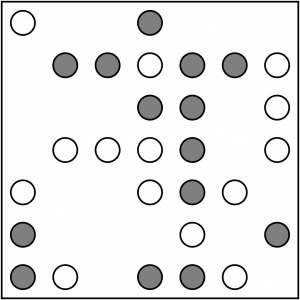
This is the puzzle we are going to solve. It’s an easy Level 1 puzzle, which serves as a nice warm-up before you go and tackle something more complex.

We’ll begin in the corners, because that’s the easiest place. Circles in a corner have half as many directions they can be connected in as circles in the middle of the board.
Note that a circle doesn’t have to be physically tucked right into a corner to count as a ‘corner’, it’s just at the extremes of the board on two axis.
The four highlighted circles here all have a single valid connection possibility, i.e. there is only one valid circle of the opposite colour to which they can be connected.
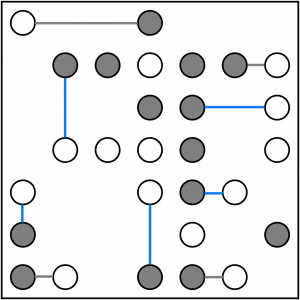
Next we can work around the edges. Again, we are using the restricted connection opportunities to our advantage. Edge circles have one fewer direction they can connect in.
As with corner circles, edge circles don’t have to be physically on the edge of the board, just at the extremity of an axis, thus reducing their connection directions by one.
Going around the outside gives us five more connections.
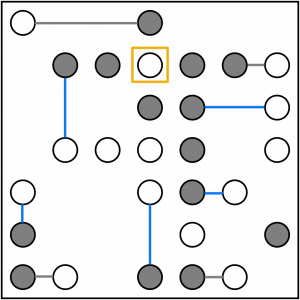
Consider the circle highlighted in orange. In theory, it could connect to the left, right, or below – three different possibilities. It’s easy to work out which is the correct option though. If we connected it to the circle below it, the one to the right of it would become orphaned – there would be nothing left to connect it to.
If we connected the highlighted circle to the one on the left, we would be orphaning another white circle, so that cannot be valid either.
The only valid option then, is to connect it to the black circle to its right.
Of course, we could also have worked this out from the fact that the black circle to the right can only be connected in one direction, but this was a good opportunity to show how keeping an eye out for potential orphans can be a path to finding connections!
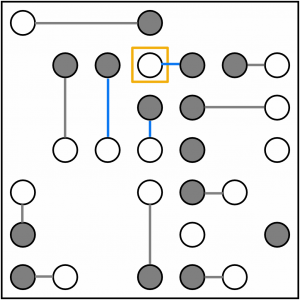
Connecting that circle makes it easy to connect the other two black circles surrounding it, as they now only have a single possible direction each.
Almost done, there’s just two pairs left, and there’s only one valid way to connect them up…
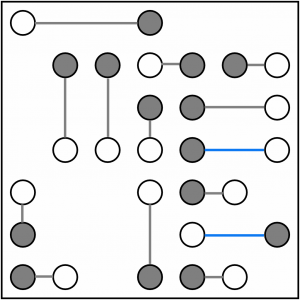
…and that’s it, every circle is paired up. None of our lines are crossing, or passing through other circles, or running diagonally, so we have a valid solution.
This was a very easy puzzle. Are you ready to have a go at something more challenging? Read on!
We’ve put together a taster of four starter puzzles for you to try out, including the example above. You can download and print the PDF below. Solutions are included, but no cheating!
Want to try out some Shirokuro? We have options. Puzzle Weekly Presents: Shirokuro is a collection of 120 puzzles over seven levels of difficulty. With one puzzle per page, every grid has space to breathe.
We sometimes include Shirokuro puzzles in our free Puzzle Weekly magazine too – you should totally sign up for that if you haven’t already, as it puts 28 brand new puzzles in your inbox every week. The puzzles get progressively harder throughout the week, working up to Level 7 by Sunday.
You can also find four levels of Shirokuro puzzles in our Jumbo Adult Puzzle Book – which happens to include more than 500 puzzles of 20 different varieties.